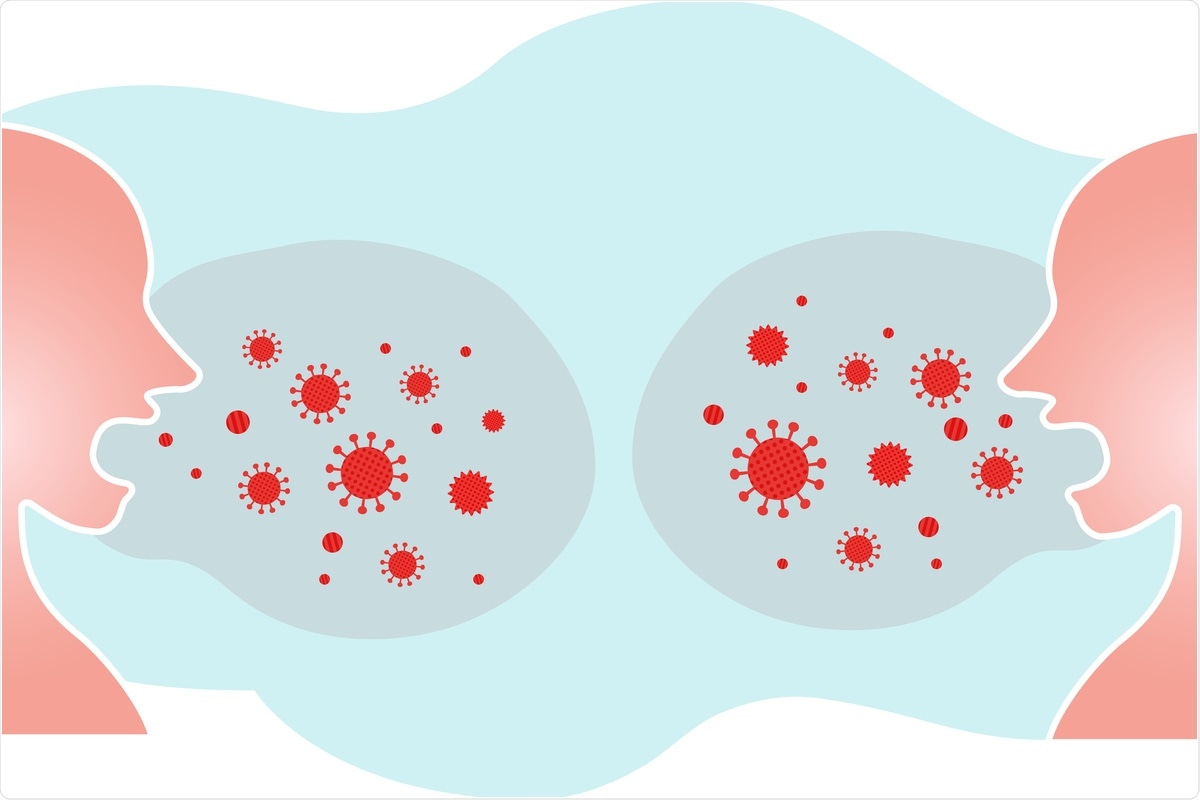Connection between aerosol transmission and COVID-19 dynamics

Superspreading events and overdispersion are characteristics of the coronavirus disease-2019 (COVID-19) pandemic, similar to other outbreaks of respiratory viruses. Here, the term "superspreading" refers to any event that leads to more than the average number of secondary transmissions. In the context of communicable diseases, "overdispersion" implies a non-random pattern of clustering, involving a large number of zero cases and a small number of larger outbreaks.
 Study: Analysis of overdispersion in airborne transmission of Covid-19. Image Credit: suma2020/ Shutterstock
Study: Analysis of overdispersion in airborne transmission of Covid-19. Image Credit: suma2020/ Shutterstock
At individual-level variation, superspreading events present as overdispersion in severe acute respiratory syndrome coronavirus 2 (SARS-CoV-2) transmissions, with 10-20% of index cases responsible for 80% of secondary cases. Hence, understanding the nature and characteristics of superspreading events is a key to comprehending and predicting SARS-CoV-2 spread.
Numerous contributing factors have been proposed for pattern transmissions, such as non-repeating, random contacts, social and micro-environmental factors, and intrinsic characteristics of viruses. Nevertheless, there exists strong recent evidence of airborne transmission of SARS-CoV-2 by respiratory aerosols.
Multiple small respiratory droplets (size <100µm at point of exhalation) or aerosols can remain airborne in the liquid or semi-solid state encapsulating the SARS-CoV-2 virus—which renders the virus infectious within the aerosols for a substantial length of time. Researchers have demonstrated that aerosols of initial size <50 µm pose the highest infection risk and variation in the corresponding viral load and may cause large variations in the number of secondary infections.
A simulation study published on the medRxiv* preprint server explored event-level overdispersion of SARS-Cov-2 spread, utilizing real-world inputs from a large number of social gatherings.
The study
The chances of infection from inhalation of infectious aerosols generated from speaking and breathing in an indoor, confined, and ventilated micro-environment was identified through a model. The model was then connected to an algorithm that accepts randomized inputs from distributions of viral load, exhaled aerosol size distribution, ventilation rate, speech, and exposure time in specific indoor areas. Such data were obtained from full-service restaurants from ten major US cities.
Therefore, the study focussed on disease spread by non-repeating contacts of asymptomatic infectious cases. Only speech and breath were deemed as mechanisms of ejection of respiratory aerosols into specific micro-environments.
The results demonstrated strong inhomogeneity of virus concentration in indoor settings. It was observed that a reduction in the probability of infection might not be proportional to the decline in virus concentration indoors. On the other hand, simulated outdoor conditions exhibited much smaller infection probability, both near and far from the source—owing to the higher rate of air changes per hour, absence of confinement, and free viral decay.
It was also noted that extreme variation in viral load correlated to a similar variation in secondary infections and individual-level infectivity. Moreover, the higher number of individual-level and secondary infections occur at lower air exchange rates.
In contrast, most occur at an intermediate air exchange rate, as very low and very high air exchange rates are less common. Additionally, the results depicted that the joint contribution of overdispersed viral load and overdispersed occupancy results in overdispersion of secondary infection, causing superspreading events.
Furthermore, the original variant's individual level and secondary infectivity was 0.13, whereas, for the delta-variant, it was 2.64, over an hour of exposure time on average. Hence, the delta-variant could be nearly 20 times more transmissible than the original variant over an hour of contact. However, the viral load and infectiousness potential may not be directly proportional.
Meanwhile, uniformly high ventilation rates and mask usage can significantly reduce transmissibility for the original variant – from 0.13 without any interventions to 0.04 with preventive measures. However, for the delta-variant, the effect of such intervention is less pronounced – with the transmissibility of 2.64 without any interventions to 1.69 with these preventive measures.
While estimating the kind of spread expected for the delta-variant, given the period of exposure and available occupancy data, in a population where a large fraction is already vaccinated – a significant drop in the number of secondary infections and superspreading events was predicted. Here, no change in viral load or change in the distribution of infectious cases was assumed.
It was stated that the finite risk of superspreading event sustains, yet with 80% vaccination and 50% reduced occupancy in social gatherings – like restaurants, coupled with masks, a significant reduction in overdispersion can be attained. Therefore, high-quality masks, reduced occupancy, and higher ventilation rates are effective preventive measures against COVID-19.
Conclusion
The results of this simulation depicted that the aerosol transmission route accounts for the overdispersed individual infectivity, while viral load variability is a dominant factor controlling the secondary attack rates. Other important factors contributing to secondary infections are – ventilation rate, exposure time, and speaking time.
Significant reduction in transmissibility and dispersion of the highly transmissible delta-variant requires all possible mitigation measures – high-quality masks, high ventilation rates, and reduced occupancy, despite a significant fraction of the population being vaccinated.
*Important notice
medRxiv publishes preliminary scientific reports that are not peer-reviewed and, therefore, should not be regarded as conclusive, guide clinical practice/health-related behavior, or treated as established information.
- Chaudhuri, S. et al. (2021) "Analysis of overdispersion in airborne transmission of Covid-19". medRxiv. doi: 10.1101/2021.09.28.21263801.
Posted in: Medical Science News | Medical Research News | Disease/Infection News
Tags: Breathing, Coronavirus, Coronavirus Disease COVID-19, micro, Pandemic, Respiratory, SARS, SARS-CoV-2, Severe Acute Respiratory, Severe Acute Respiratory Syndrome, Speech, Syndrome, Virus

Written by
Nidhi Saha
I am a medical content writer and editor. My interests lie in public health awareness and medical communication. I have worked as a clinical dentist and as a consultant research writer in an Indian medical publishing house. It is my constant endeavor is to update knowledge on newer treatment modalities relating to various medical fields. I have also aided in proofreading and publication of manuscripts in accredited medical journals. I like to sketch, read and listen to music in my leisure time.
Source: Read Full Article




